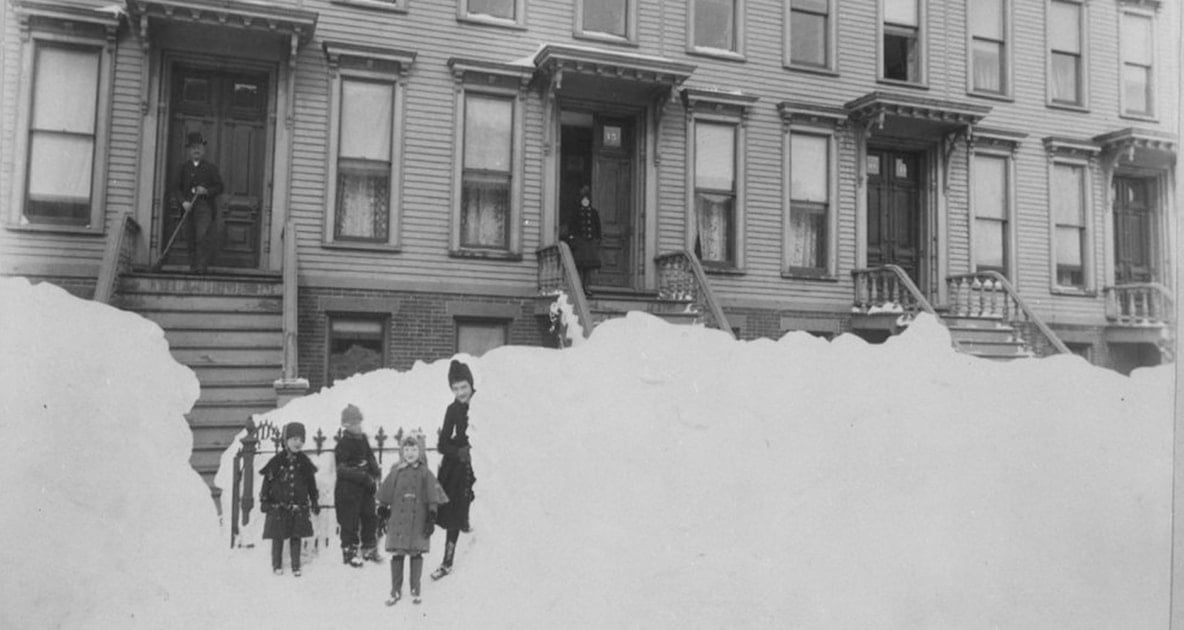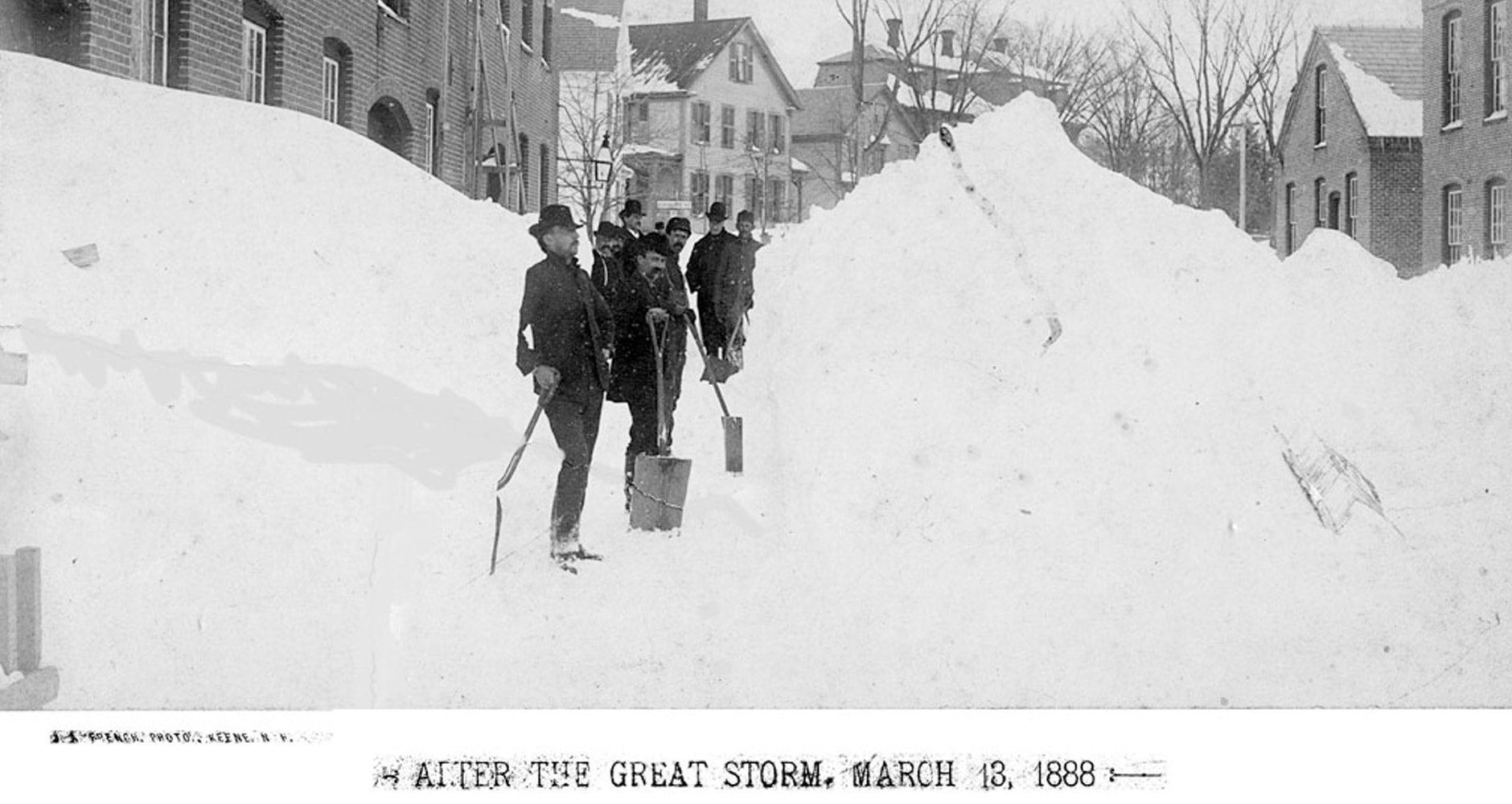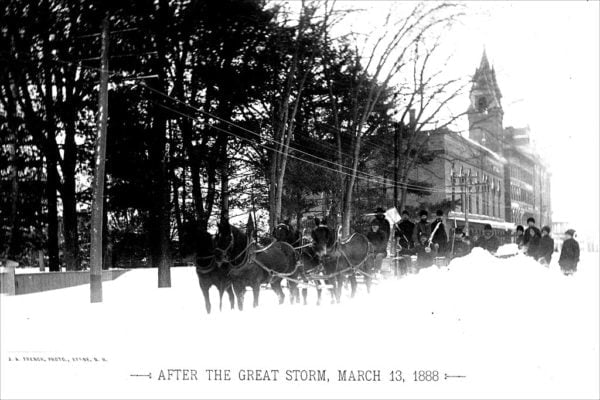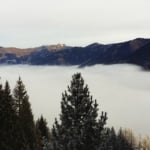The Big One: The Blizzard of 1888
The Blizzard of ’88, also known as “the Great White Hurricane,” gripped the Atlantic seaboard from the Chesapeake Bay northward to Canada’s Maritime Provinces, and is considered one of the worst snowstorm in U.S. history. We take a look back.

In 1888, President Grover Cleveland was defeated by challenger Benjamin Harrison, the wax drinking straw, the time card clock, and the ballpoint pen were patented; golf came to America for the first time, George Eastman produced the first Kodak camera, National Geographic magazine published its first issue, the Washington Monument opened to the public, and the Eastern half of North America endured what has been called the worst blizzard in U.S. history.
The Big One
For four full days, beginning on March 11, the Great Blizzard of ’88, also known as “the Great White Hurricane,” gripped the Atlantic seaboard from the Chesapeake Bay northward to Canada’s Maritime Provinces. Just two months earlier the infamous Schoolhouse Blizzard had claimed the lives of more than 200 people, most of them children, in the Midwest. As tragic as that storm was, however, it was minor in comparison to the big one that would soon hit.
The Blizzard of ’88 dumped as much as 50 inches of snow on parts of the Northeastern United States. The unprecedented amount of snow was accompanied by temperatures in the single digits, which were unusual for March, and punishing winds in excess of 45 miles per hour. Some reports even claimed there were gusts up to 80 miles per hour! By the time the storm was over, it left behind snowdrifts 50 feet high and claimed more than 400 lives, half of them from New York alone.
Railroads stopped running, ships were grounded, and many of those that were unlucky enough to be on the water when the storm hit wrecked. A full quarter of the people who lost their lives during the storm were sailors. Telegraph and electrical wires, which were a fairly recent addition to New York and a few other large cities, were downed, creating a hazardous situation. This situation was worsened by the fact that fire stations were unable to respond due to impassable roads. Unchecked fires were responsible for more than $25 million in property damage related to the storm (or more than $26 billion in today’s dollars). Later, as the snow from the storm began to melt, severe flooding occurred, causing even more damage.
Most people found themselves confined to their homes for duration of the brutal storm and its aftermath. In many places, it took as long as eight days after the snow ended to make roads passable. The storm was, in part, responsible for the creation of Boston’s subway system — the nation’s first — which opened nine years later, in 1897. New York City, would soon follow suit, opening its subway system in 1904.
Main image: Blizzard of March 1888, Brooklyn, New York – Wikimedia Commons

Jaime McLeod
Jaime McLeod is a longtime journalist who has written for a wide variety of newspapers, magazines, and websites, including MTV.com. She enjoys the outdoors, growing and eating organic food, and is interested in all aspects of natural wellness.








Thank you for all the wonderful stories. I’m glad I live in Arizona now. I’m a wimp.
Interesting article! Love reading about historic weather events.
I live in massachusetts and honestly do not recall having any storms october 31st 2011. I remember getting some snow that day but hardly even a half a foot lol that was not a snow storm at all. Just a flurry. And by the way…. I live on the end closest to connecticut. They barely got anything as from what I seen/heard too. Last year we had a lot of snow but nothing compared to the ’78 blizzard or ’88.
The difference everyone is mentioning isn’t the inches of snow as much as it was the deaths: over 400! Yes, we’ve had more snow and blowing winds, but nowhere near the loss of lives with the ’88 storm.
Did anyone remember the “Blizzard”/Nor’Easter of 1978? The whole northeast was stranded. People were stranded at work places, some ventured out and vehicles just could not go anywhere. Snow coming down at inches an hour, wind blowing at full force. Being a Nor’easter, coastal heavy wet snow, described as a cement wall if plows just could not budge it. All forces had to send for extra equipment which came out from Buffalo, They were so amazed at the fact they could not move , they explained it as trying to move cement. And folks, that’s what you call a Blizzard!
That’s just considered a dusting around here…..During the Great Blizzard of 1966, a three-day Nor’easter blended with lake effect squalls to leave my home town of Fulton, N.Y. buried under nearly 200 inches – 16 feet – of snow.
Check it out here/http://www.usatoday.com/weather/storms/2007-02-06-ny-snow_x.htm
We had the blizzard 0f 1977 in Western New York. Shut down everything from Erie, Pa to past Buffalo. Nothing could move with all the snow from lake effect snows and very high winds. It took the National Guard to dig us out. Houses along the lake were buried over the roofs in snow drifts.
I am surprised that you did not mention the October 31st storm from just this past 2011. It was named Storm Alfred. Connecticut and Massachusetts had over 14 – 16 inches of snow and snapped trees in half. Connecticut looked like a war zone. Many people were without power for two weeks.
What a great story my great great grandparents actually died in this storm and left my great grandfather orphaned.